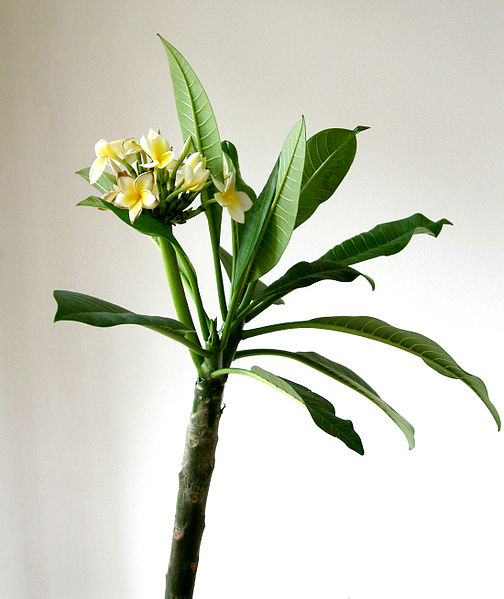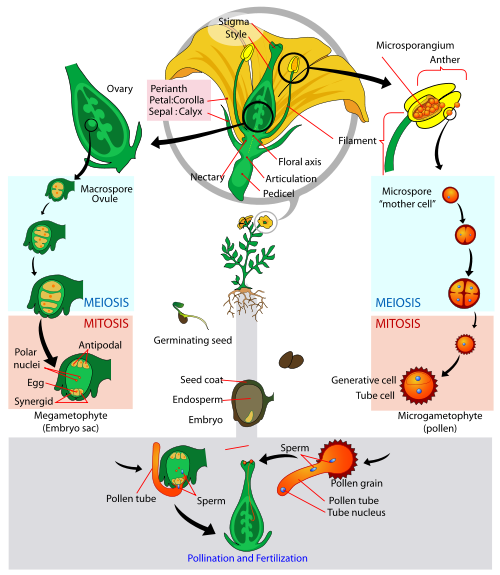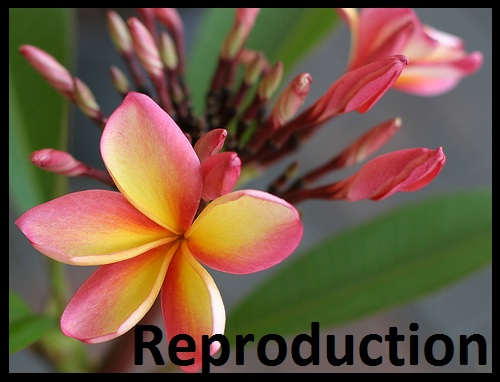The Frangipani is part of the phylum Magnoliophyta which is also called angiosperms.
 "Angio" means
covered and "sperm" means seed, so the reproductive organs are
protected. Overall, angiosperms are more resistant to drought
and cold because of the extra protection that they exhibit. As
stated in Nutrition, the best
conditions for the Frangipani to reproduce are slightly acidic
soil, warm temperatures, and they do not need a lot water to
survive.
"Angio" means
covered and "sperm" means seed, so the reproductive organs are
protected. Overall, angiosperms are more resistant to drought
and cold because of the extra protection that they exhibit. As
stated in Nutrition, the best
conditions for the Frangipani to reproduce are slightly acidic
soil, warm temperatures, and they do not need a lot water to
survive.
Also, because their seed is covered, the pollination process is
more selective. Unlike pollen in gymnosperms, "naked seeds",
which can be pollinated by wind and water and end up anywhere,
the seeds are protected by a fruit when they are dispersed.
Angiosperms are flowering
plants, and their flowers allow for specialized means of
pollen transfer. Specifically, Frangipani possess highly
 perfumed flowers which surely attract humans and other little
critters in the garden. They also bear seeds that are enclosed
in a fruit. As you can see in the picture to the left, pollination
occurs when the pollen enters the ovary via the stigma of the
plant. When the sperm reaches the ovary, fertilization takes
place. The ovule, which is found in the ovary, then develops
into the seed. You can also see in the picture that the ovary
stays around the ovule and is a protective covering for the
seed. (Think of an apple... we consider the apple the fruit,
then once we eat it the seeds are exposed on the inside of the
fruit.) Then the seed grows and grows until eventually it
attaches to something such as an animal or human, or maybe it is
carried away by wind or water. Frangipani are unique in that not
every plant produces fruit which are in the form of a seed pod.
The fruit is a dry, brown seed pod that can range in size from
15-30 cm.
perfumed flowers which surely attract humans and other little
critters in the garden. They also bear seeds that are enclosed
in a fruit. As you can see in the picture to the left, pollination
occurs when the pollen enters the ovary via the stigma of the
plant. When the sperm reaches the ovary, fertilization takes
place. The ovule, which is found in the ovary, then develops
into the seed. You can also see in the picture that the ovary
stays around the ovule and is a protective covering for the
seed. (Think of an apple... we consider the apple the fruit,
then once we eat it the seeds are exposed on the inside of the
fruit.) Then the seed grows and grows until eventually it
attaches to something such as an animal or human, or maybe it is
carried away by wind or water. Frangipani are unique in that not
every plant produces fruit which are in the form of a seed pod.
The fruit is a dry, brown seed pod that can range in size from
15-30 cm.
To see how other organisms use and interact with the Frangipani, visit the next page!
![]()
![]()
Take me Home
